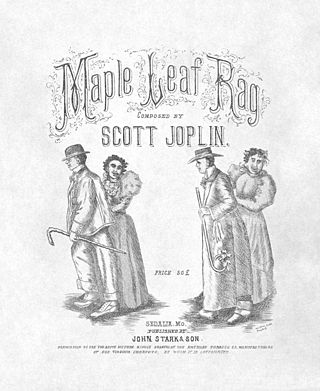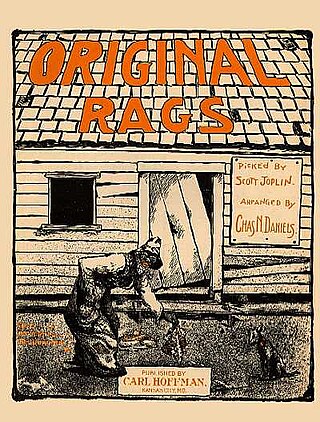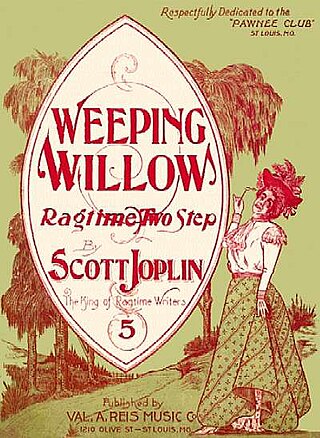
Ragtime, also spelled rag-time or rag time, is a musical style that had its peak from the 1890s to 1910s. Its cardinal trait is its syncopated or "ragged" rhythm. Ragtime was popularized during the early 20th century by composers such as Scott Joplin, James Scott, and Joseph Lamb. Ragtime pieces are typically composed for and performed on piano, though the genre has been adapted for a variety of instruments and styles.

Scott Joplin was an American composer and pianist. Dubbed the "King of Ragtime", he composed more than 40 ragtime pieces, one ragtime ballet, and two operas. One of his first and most popular pieces, the "Maple Leaf Rag", became the genre's first and most influential hit, later being recognized as the quintessential rag. Joplin considered ragtime to be a form of classical music meant to be played in concert halls and largely disdained the performance of ragtime as honky tonk music most common in saloons.
Sheet music is a handwritten or printed form of musical notation that uses musical symbols to indicate the pitches, rhythms, or chords of a song or instrumental musical piece. Like its analogs – printed books or pamphlets in English, Arabic, or other languages – the medium of sheet music typically is paper. However, access to musical notation since the 1980s has included the presentation of musical notation on computer screens and the development of scorewriter computer programs that can notate a song or piece electronically, and, in some cases, "play back" the notated music using a synthesizer or virtual instruments.

The "Maple Leaf Rag" is an early ragtime musical composition for piano composed by Scott Joplin. It was one of Joplin's early works, becoming the model for ragtime compositions by subsequent composers. It is one of the most famous of all ragtime pieces. Its success led to Joplin being dubbed the "King of Ragtime" by his contemporaries. The piece gave Joplin a steady if unspectacular income for the rest of his life.

Classic rag is the style of ragtime composition pioneered by Scott Joplin and the Missouri school of ragtime composers. These compositions were first considered "classic" by Joplin's publisher, John Stark, as a way to distinguish them from what he considered the "common" rags of other publishers. Today, any composition fitting this particular ragtime structural form is considered classic rag.

"The Entertainer" is a 1902 classic piano rag written by Scott Joplin.

The "Swipesy Cakewalk" is a ragtime composition published in 1900 by a musical duo consisting of Scott Joplin, who likely composed the trio, and the young composer Arthur Marshall, who most probably composed the rest of the piece with oversight from Joplin. "Swipesy" uses the simple syncopations of a cakewalk - the first beat being a sixteenth, eighth, sixteenth note division, and the second beat an even eighth note division. The style follows the AA BB A CC DD musical form common for both cakewalks and rags, particularly after the earlier publication of Joplin's hit "Maple Leaf Rag". Although called a cakewalk, it departs from the cakewalk form in favor of the more standard ragtime idiom at various points, most notably throughout the C (Trio) section. "Swipesy" was most likely written in the late 1890s when Joplin was living with the Marshall family and teaching Arthur composition.

"Magnetic Rag" is a 1914 ragtime piano composition by American composer Scott Joplin. It is significant for being the last rag which Joplin published in his lifetime, three years before his death in 1917. It is also unique in form and in some of the musical techniques employed in the composition.

"Original Rags" was an early ragtime medley for piano. It was the first of Scott Joplin's rags to appear in print, in early 1899, preceding his "Maple Leaf Rag" by half a year.

"Weeping Willow" is a 1903 classic piano ragtime composition by Scott Joplin. It was one of Joplin's simpler and less famous ragtime scores, written during a transitional period in his life, and one of the few pieces that Joplin cut as a piano roll in a 1916 session.

"Bethena, A Concert Waltz" is a composition by Scott Joplin. It was the first Joplin work since his wife Freddie's death on September 10, 1904, of pneumonia, ten weeks after their wedding. At the time the composer had significant financial problems; the work did not sell successfully at the time of publication and was soon neglected and forgotten. It was rediscovered as a result of the Joplin revival in the 1970s and has received acclaim from Joplin's biographers and other critics. The piece combines two different styles of music, the classical waltz and the rag, and has been seen as demonstrating Joplin's excellence as a classical composer. The work has been described as "an enchantingly beautiful piece that is among the greatest of Ragtime Waltzes", a "masterpiece", and "Joplin's finest waltz".

"The Easy Winners" is a ragtime composition by Scott Joplin. One of his most popular works, it was one of the four that had been recorded as of 1940.

"Sunflower Slow Drag" is a ragtime composition by Scott Joplin and Scott Hayden. It is about four minutes long and has been described as "full of gaiety and sunshine".

"The Ragtime Dance" is a piece of ragtime music by Scott Joplin, first published in 1902.
"The Silver Swan" by Scott Joplin is a ragtime composition for piano. It is the only known Joplin composition to be originally released on piano roll instead of in musical notation.
The Six Little Preludes are a group of preludes written by the composer Johann Sebastian Bach for harpsichord. They are all short, pedagogical efforts written in or around the period of 1717–1720, but they were not published until 1802. These pieces are all short but require a strong understanding of technique. The preludes are a part of Bach's 18 Kleine Präludien, which also contains the Twelve Little Preludes. Bach sporadically produced the pieces around 1717–1720, primarily for instructive purposes. They were not intended for public performance, rather as an aid to his son's compositional development.

The "Searchlight Rag" is a ragtime composition by Scott Joplin, first published in 1907. It was named after the town of Searchlight, Nevada, where his friends had gone prospecting, inspiring the title.
Elite Syncopations is a one-act ballet created in 1974 by Kenneth MacMillan for The Royal Ballet.

"Wall Street Rag" is a ragtime composition by Scott Joplin, first published in 1909. As indicated by the title, the theme is based on Wall Street following the events surrounding the Panic of 1907. This is represented in the musical structure along with its corresponding annotations.















